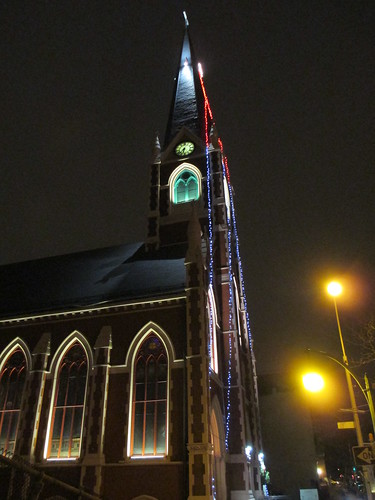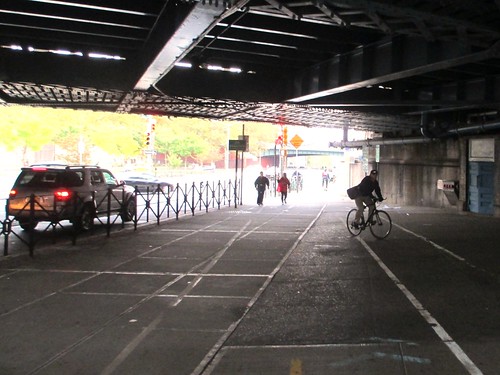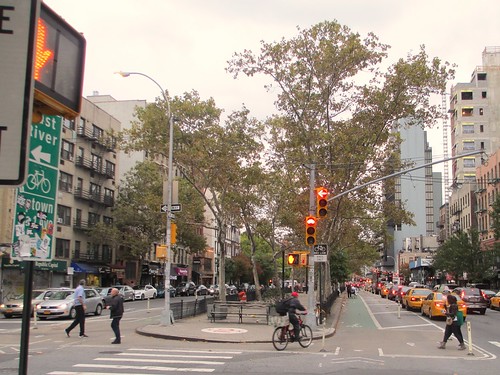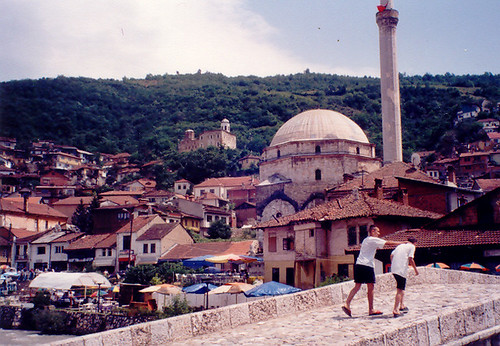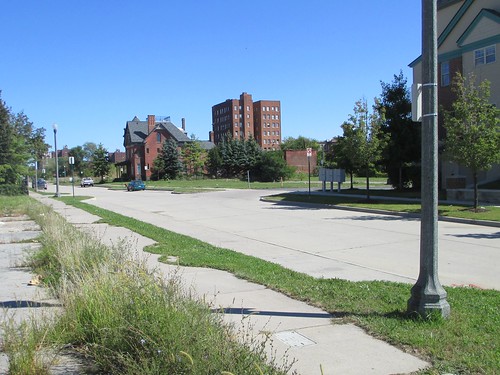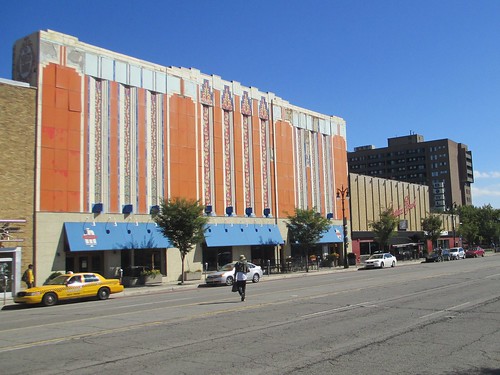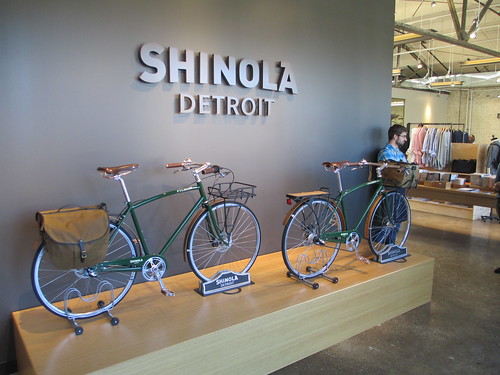It was around 12.45 in the early hours of last Thursday
morning, as I bounced and dodged along the rutted, uneven surface of Grand St, my new route home through SoHo , that I came across an obstacle of the kind one’s
apt to encounter at that time of night in a big city. Workmen had closed the
street as they moved equipment into and out of the work sites that have been
dotted along much of that street for the last year or so. A big sewer underneath is being replaced. I picked up my bike and, eager to get home after a 16-and-a-half
hour work day, wheeled it along the sidewalk past the obstruction. Then I got
back on, cycled a block and waited for a red light.
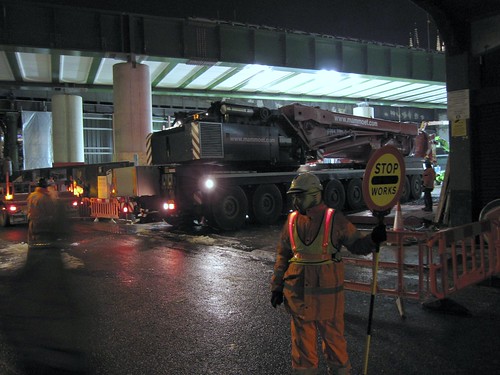 |
| A late-night workman bars my way by London's Southwark Cathedral: similar to my Grand St experience, if less poetically picturesque |
As I paused, however, I experienced one of those moments on
a bike that takes the mind racing off to all kinds of other places. To my left,
peering into one of the holes for the sewer, was a safety-helmeted workman. The
man, who looked to be of Amerindian descent, looked weather-beaten and sad. I could
see his wizened, resigned face in minute detail because of the lights shining
up from the work site down in the hole. The expression and unusual lighting
gave the picture a timeless feeling. The scene I was witnessing on a New York
city street in 2013 could almost as easily have been from some 17th
century painting depicting shepherds peering from the dark into a lit stable to
adore the newborn Christ.
It was also, it occurred to me, the kind of encounter that’s
more common when one’s cycling very late at night or very, very early in the
morning – the times when one’s out on one’s bike and most of the rest of the
world is asleep. The few people one sees are out for some specific purpose
– fixing the streets or transit system, disposing of yesterday’s detritus,
delivering the coming day’s food, continuing a celebration that started the
previous evening or ensuring public safety. The encounters take on a far more intense flavour
than the countless interactions of a bike journey at a more normal time of day.
I’ve had things thrown at me at those times of day, helped a mugging victim and
come upon a lone woman jogging through an entirely darkened city park.
 |
| Cycling late at night can feel ghostly quiet. But I've never felt quite as ethereal as I made this Copenhagen cyclist look. |
However, my main memories are of the peculiar euphoria that
comes from rushing (as one often can) through a city that’s so calm and devoid of its usual sounds as to seem like an entirely different place.
It’s a form of riding of which I have disproportionate
experience. Early in my career, when I worked for The Scotsman in Edinburgh ,
I had bursts of working as the late-shift reporter. I’d come into the office
for 6pm, work until the paper’s final edition was done at 1am then head home by
bike through the Scottish capital’s old town. I remember bowling across the
Meadows – a rough Edinburgh mixture of Central Park and Boston Common, American readers – on crisp, clear nights, along lines of trees,
speeding towards home.
 |
| A lit-up building by Park Lane: a scene I'd witness looming across the road at me as I cycled early morning or late at night to or from Paddington Station. |
When I moved later to London ,
I often had to catch early-morning trains or flights. Quite the most
challenging were the times I had to go to Paris
for the day and catch the 5:25am train from St Pancras, eight miles from my
house, checking in at 4.55am. I’d dash across town in the early morning quiet,
down roads that a few hours later would be prohibitively busy, at a steady
20mph. On arrival, I’d often wonder that I’d dared go as fast as I had, given
the load of laptop, washbag and so on often weighing down my panniers,
threatening to pitch me into the road if I hit a pothole.
On such journeys, the loudest sound to be heard was often
the long rattle as some early morning shopkeeper or underground station manager
lifted up his security roller shutter. The rat-a-rat-a-rat-a-rat-a sound would
echo off the face of the opposite buildings, disturbing the dawn stillness. There
was also sometimes, on side streets, the distinctive hum-and-rattling-bottles
of a British electric milk float doing its rounds.
Other than that, there was a strange feeling that this was a
world with its mute button on. Police vans or ambulances would often rush by,
at speed, but on empty roads only the lights would flash and the engine emit
the slightly higher-pitched hurry-hurry-hurry sound that says the driver has
his foot firmly to the floor. There would be a gentle “whoosh!” sound as the
vehicle passed, then a resumption of the quiet.
But one would also come upon people. One frosty morning in
February 2006, I cycled from Brixton to Shepherd’s Bush to give a 6.30am
interview at BBC Television Centre. As I rode shortly after 5am through a
pitch-black Battersea
Park London ’s
most dedicated fitness fanatic.
A couple of years before, cycling home late on a Friday night through
Camberwell, South London, I noticed a woman
hunched over on the pavement by the roadside shouting, “They got all my money!”
Looking down the road, I saw the silhouettes of three young men running away
across the street. I talked to her and took her into a neighbouring ambulance
station while we waited for the police. The incident – along with the time I
heard the smash of a thrown bottle that had just missed me at midnight in a
public housing estate – persuaded me to stick mainly to main roads at such
times of the night.
The ambulance crews offered the woman tea and very British
calming words as she sobbed hysterically about how she was meant to be at a
friend’s wedding the next day. It was another scene played out in a mixture of
darkness and the warm light from inside the ambulance station. The picture – the
ambulance drivers gathered in quiet concern round the seated, weeping victim –
had an Old Master timelessness similar to the scene I would much later witness by
the hole in Grand St.
But the level of activity I encountered last week on Grand
St – and the fact I was also recently stopped there late at night for a filmshoot – illustrate something rather different about cycling late at night in
New York. The subways don’t stop just after midnight as the London Underground does. One’s apt to come upon sudden busy scenes even in the small hours of the
morning. A couple of times recently, I've cycled across the Manhattan Bridge at
12.30am and seen below me three lanes of traffic on FDR Drive. How strange, it seems to me, cycling on my own a hundred feet above them, to be stuck as 1am approaches, staring at the rear lights of the car in front.
There are, however, subtle signs in New York when it’s late. One’s more likely to pass a work train rumbling behind a diesel engine along theManhattan Bridge
There are, however, subtle signs in New York when it’s late. One’s more likely to pass a work train rumbling behind a diesel engine along the
 |
| A late-night New York City skyline: fine fingers of Art Deco elegance from the Empire State and Chrysler buildings. |
But there is still a special magic about riding when most people are sleeping, even in the city that itself never does so. I saw one woman striding down Boerum Place in downtown Brooklyn at 11.30pm, holding a small child’s hand and
yelling accusations desperately at whoever was on the other end of her
cellphone. There was the guy I encountered one night recently so drunk that I
feared I’d be obliged to accompany him all the way home.
The most striking moments, however, are the ones where the
dark and the shafts of light interact to pick out a startling detail. One’s eye
will catch the lights on the Chrysler
Building
